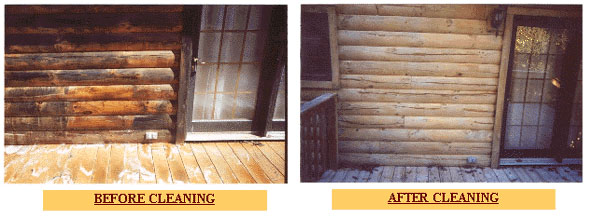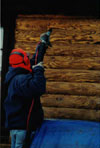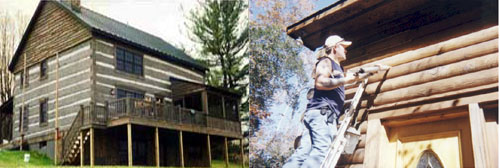Log Home
Repair and Restoration Services


Frequently Asked Questions ...
and Answers:
What should I do to fully restore my home/cabin?
There are a number of steps to follow in restoring your home. They
are listed in order below.
- Assess your home for damage and determine what your goal is.
- Explore your options and either hire the work out to an experienced
company like Appalachian Log Care or investigate into how to do the work yourself.
- Start work. Make sure you perform the work items in the right sequence.
This depends on the look you are going for (contrasted or blended)
and what your overall restoration goal is. The work sequence for a
full restoration is as follows:
- Surface Preparation (corn blast and wash, bleach and borate)
- Log repair/Replacement
- Caulk/Chink
- Stain
- Clear Coat
  What
are the benefits of Corn Blasting? What
are the benefits of Corn Blasting?
-
It removes up to 98% of any existing stain or paint off the logs.
Since the logs are brought back to the original bare wood surface
a borate can be applied to prevent rot growth and protect the logs
against insect infestation.
-
When you go to restain the home in most cases you can go lighter
or darker with the stain. This means that your log homes new look
is up to you.
-
Unlike other strippers on the market corn media is easy to clean
up, biodegradable and doesn’t pit the logs as much as sand
will.
Are my logs rotten? Can they be fixed?
Walk around your home and really examine each log. Find logs that may
look darker in color than the others, logs with a lot of bug holes or
logs that have fungus growing on them. Hit the logs and listen for hollow
spaces, take a knife and try to insert it into the log, if it goes in
smoothly and far you know that log has a rotten area. To prevent future
log damage remove the existing sealer off the logs by corn blasting,
install impel rods in areas where rot is starting, apply borate into
the logs, chink and caulk all seams to prevent water damage and apply
a breathable sealer. Remember that rot spreads like a cancer. If one
log is rotten and you ignore it other logs around that log will eventually
become rotten as well. The cheapest way to handle rotten logs is to
fix them right away and maintain your home properly.
 What
do I do for Insect Infestation? What
do I do for Insect Infestation?
The best way to deal with insects is to prevent them from the start.
When building a new home make sure you apply an insect treatment over
all areas and when the home is completed seal it in so if the insects
bore into the log and eat the wood they will die. If you have a severe bug problem you should corn blast
and apply a highly concentrated termicide, insecticide and fungicide
solution for deep penetration into the logs. Reseal the home with a
breathable sealer with a bug additive for best protection. Also rotten
areas are bug havens and need to be fixed properly to get rid of them.
Why should I caulk or chink my home?
This is the most frequently asked question and the most overlooked.
Some log home manufacturers advertise that their homes are "chinkless"
but in actuality no home is. Even if the logs are tight against each
other with barely a seam, water and bugs will find a way in and eventually
that may lead to log damage. Not only, does properly caulking and chinking
prevent damage to the logs but it also dramatically helps with
heating and cooling costs. Areas most affected by caulking and chinking
are: Log lateral seams, upchecks, log corner areas, around windows and
doors, roofline seam, chimney seam etc…
Contrasted

|
Blended
 |
What is the difference between the most popular log home looks?
Blended vs. Contrasted.
What our company calls a blended look is when the home is chinked
and then stained over with a similar color. This hides the chinking
and gives the home a one-color appearance. (See picture) This is usually
the look for homes with many log layers and with small gaps between
the logs. There aren’t many drawbacks to this look. It allows for
easy maintenance and future stain applications. One hint: keep a pail
of stain in the garage or shed in case of any chink touch up work.
What our company calls a contrasted look is when the home is stained
and then chinked with a different color, usually mortar white or light
gray. (See picture) This is usually the look for homes with less log
layers, larger diameter logs, or wide seams. This gives the home a very
dramatic appearance and a real special and unique look that varies from
the conventional log look. When you
go to restain you will either hand brush the stain on or spray
the stain and use a chink paint over the chinking area to get the contrast look.
How do I get an estimate?
There are two ways to receive an estimate from our company. The
first is FREE and involves the homeowner to do most of the work. This
involves:
- Taking pictures of the home at angles where all four sides can
be captured.
- Filling in our FREE ESTIMATE form
- Emailing or regular mailing this information to our company as
directed on the form.
The second way is an on site survey. This way has a cost attached which
varies depending on your location. This involves:
- Contacting our office to schedule
- Setting up a date
- Meeting with our trained log home specialist who will take pictures
of the home, review the home for damage, and measure the home.
Both of these methods will give you an estimate with a detailed description
of all recommended work items. When you sign up with our company the
survey fee will be subtracted out from the total contract price, otherwise,
it is just the price for the information you were provided with from
our company.
Do you have more questions that
we haven't answered?
Call or Email us for the answers!
800-726-0708
info@logcareproducts.com
RETURN TO TOP
BACK TO RESTORATION TABLE OF CONTENTS
| 